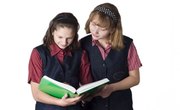Parents want the best educations for their children. In some cases, public schools provide a rigorous education and plenty of extracurricular activities for students to enjoy. In other communities, public education does not satisfy parental requirements, or parents may want to give their children a religious background in addition to a well-rounded education. Parents should gather information about public and private schools to make an informed choice.
History
According to the National Center for Education Statistics, as of 2013, 9.7 percent of elementary and secondary school students were enrolled in private schools. The United States has a long history of both public and private education. According to the Applied Research Center, the first law that mandated public schools was in 1647. The first public high school was established in 1820. The first private schools were established by Catholic priests in Louisiana and Florida in the early 19th century. The Catholic church also established schools in Texas and California later in the century.
Public School Advantages and Disadvantages
There are many advantages to public schooling. In their book, The Public School Advantage: Why Public Schools Outperform Private Schools, Christopher Lubienski and Sarah Theule Lubienski found that the uniform curriculum and standards of public schools may be a factor in higher student performance. Private schools' curriculum is usually unique to the school itself. Public schools usually have a more diverse student body than private schools. Public school is free. However, the public school may suffer from funding issues that private schools generally do not have. The nonprofit organization Face the Facts states that public school teachers are more highly qualified than private school teachers. Finally, students are typically offered a wider variety of courses and also spend more time studying core classes than at private schools.
Private School Advantages and Disadvantages
Private schools usually have greater access to resources and technology than public schools, according to Education Week. Private schools usually have a smaller student body, and a lower teacher-to-pupil ratio than public schools, according to the National Center for Education Statistics. The final say is at the school level, not the district level. Private schools tend to have more parental involvement than public schools. However, there are generally fewer minorities in private school than in public school. Also, the parents of exceptional children, whether the child is gifted or whether she needs special education services, generally find that private schools cannot give their child the services she needs. Finally, there's the cost of private education, which can easily run into the tens of thousands of dollars.
Making an Informed Choice
Great Schools suggests that before parents decide whether to put their children in public school or private school, they should research both public and private schools in their area. They should list the qualities they desire in a school. Parents can take a tour of the schools in the district and ask questions, especially if their child is interested in extracurricular activities, is gifted or has special needs. If possible, parents should take their children on the tours and get their input.
Related Articles
References
- National Center for Education Statistics: Fast Facts: Educational Institutions
- Applied Research Center: Timeline of American Education
- Boarding School Review: How Private Schools Evolved in the United States
- GreatSchools: Public vs. Private vs. Charter
- Sentinel and Enterprise: Face the Facts USA: Public vs. Private: Who's ahead by degrees
- National Endowment for the Arts: Elite Private Schools Use Wide Range of Ed-Tech Strategies
Resources
Writer Bio
Lori Garrett-Hatfield has a B.J. in Journalism from the University of Missouri. She has a Ph.D. in Adult Education from the University of Georgia. She has been working in the Education field since 1994, and has taught every grade level in the K-12 system, specializing in English education, and English as a Second Language education.










